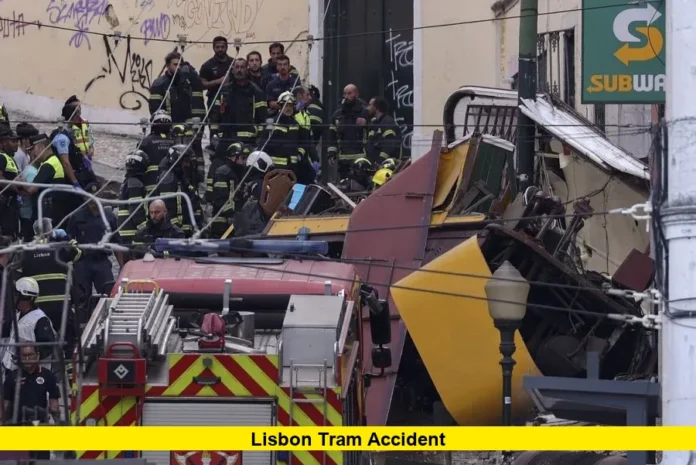The Lisbon tram accident on September 3, 2025, has left Portugal in mourning after a catastrophic derailment of the historic Glória Funicular. At least 15 people lost their lives, and 18 others sustained injuries, including several in critical condition. This tragic event occurred during evening rush hour and has become one of the most devastating public transport accidents in the country’s recent history.
The Tragic Incident
At around 6 p.m. local time, the iconic funicular, known as the Ascensor da Glória, suddenly derailed while descending its steep track that connects Restauradores Square to the Bairro Alto district. Witnesses described a loud snap moments before the tram lost control, skidding off the rails and crashing violently into a nearby building.
The impact left passengers trapped inside twisted metal. Emergency responders arrived quickly, using specialized equipment to free victims. Within hours, officials confirmed 15 fatalities and 18 injured passengers, with five in critical condition. Among the injured were tourists and at least one child.
Emergency Response
Lisbon’s emergency services mobilized in full force, deploying more than 60 rescuers and 20 support vehicles. Victims were taken to several hospitals across the city, including São José, Santa Maria, and São Francisco Xavier. Doctors reported that injuries ranged from broken bones and head trauma to life-threatening internal damage.
Authorities set up a crisis unit to coordinate rescue efforts and provide psychological support for survivors and the families of victims. Foreign nationals were also among those affected, with embassies stepping in to assist their citizens.
Investigation Into the Cause
Initial findings point to a broken haulage cable as the most likely cause of the Lisbon tram accident. The Glória Funicular operates using a counterbalanced cable system that has functioned for more than a century. Early reports suggest the cable either snapped or became loose, causing the descending car to derail uncontrollably.
The operator, Carris, has stated that all required maintenance checks were performed regularly, including daily inspections. Despite these assurances, prosecutors, police investigators, and the national transport safety office have launched a joint inquiry. The investigation aims to determine whether mechanical failure, poor maintenance, or other factors contributed to the disaster.
Historic Significance of the Funicular
The Glória Funicular has been a symbol of Lisbon since its inauguration in 1885. Declared a national monument in 2002, it attracts thousands of tourists each year. Each tram can carry over 40 passengers, making it a vital link between the bustling city center and the lively Bairro Alto district.
For many locals, the funicular is not only a means of transport but also a piece of Lisbon’s identity. The crash has therefore deeply shaken the community, with many calling it a dark day in the city’s modern history.
Government and Public Reaction
In the wake of the tragedy, Lisbon’s mayor declared three days of local mourning, while the national government announced September 4 as a national day of mourning. Flags across Portugal were flown at half-mast as a tribute to the victims.
President Marcelo Rebelo de Sousa addressed the nation, expressing profound sorrow and pledging full transparency in the investigation. The Prime Minister emphasized that lessons must be learned to prevent such a disaster from ever happening again.
Condolences have poured in from international leaders, reflecting the global shock at the scale of the accident.
Key Facts About the Lisbon Tram Accident
- Date: September 3, 2025
- Location: Glória Funicular, Rua da Glória, Lisbon
- Fatalities: 15 confirmed dead
- Injuries: 18 people injured, 5 critically
- Suspected Cause: Broken or loose haulage cable
- Operator: Carris, Lisbon’s public transport company
- Mourning Period: 3 days in Lisbon, 1 national day of mourning
- Foreign Victims: Several among the injured
A City in Grief
The Lisbon tram accident has struck a painful chord for residents and tourists alike. What was once a celebrated landmark of Portuguese culture has become the scene of unimaginable tragedy. Authorities now face the urgent task of uncovering exactly what went wrong and ensuring that transport systems in Lisbon meet the highest safety standards.
For families who lost loved ones, the pain will last long beyond the mourning period. For the city of Lisbon, the accident is a stark reminder of how even historic treasures must be constantly safeguarded against failure.
This heartbreaking event will be remembered for years to come, and the investigation’s outcome will be critical to restoring public trust in one of the city’s most beloved symbols.
The Lisbon tram accident is a somber chapter in Portugal’s history. As the city grieves and the investigation unfolds, many are left with a single hope—that such a tragedy will never happen again. Share your thoughts or experiences in the comments below to keep the conversation alive and honor the memory of those affected.
